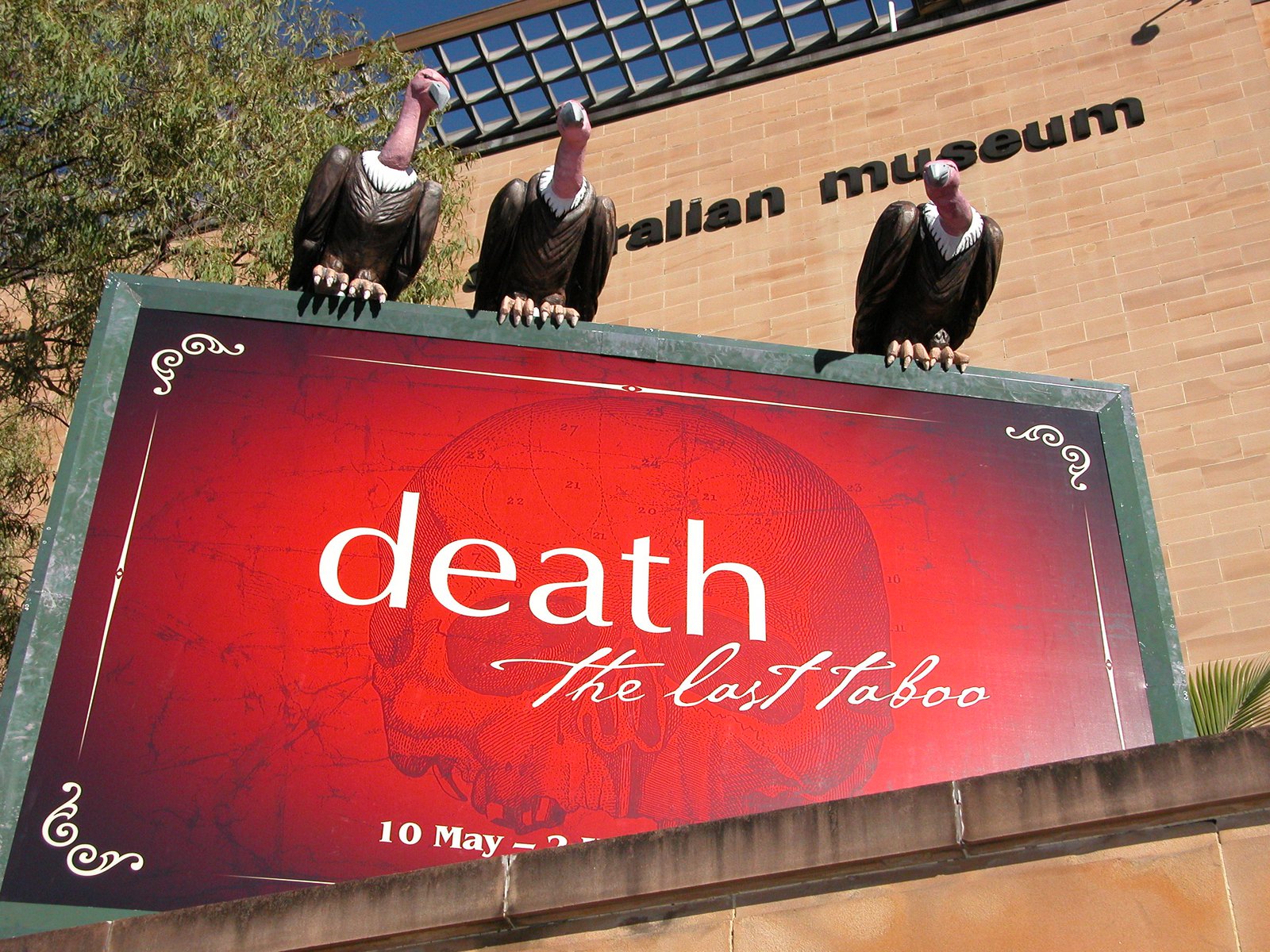The role of narrative in museum exhibitions
In her article Lohrey laments the state of exhibition design in some of our major museums, noting that they fail to tell a story. She notes that often significant objects are presented as "design pieces" without any context or story. Lohrey concludes by stating: 'The question remains of how to put an end to trophyism. Until their displays of social history are more imaginatively conceived, our major museums will remain lacklustre models of fragmentation and perfunctory exposition. There is a metaphorical heart missing from this frame, a manifest passion, and flair, for the telling of our history' (2010, p.51). What better way to reclaim this territory than through the power of narrative?

Street signage for the 2003 exhibition Death - The last taboo.
Image: Carl Bento© Australian Museum
The potential of narrative approaches to learning have been explored more recently by museums. It is recognised that humans are natural storytellers—since ancient times humans have been using stories that represent an event or series of events as ways to learn (Abbott, 2002). Bruner (1986) suggested that humans employed two modes of thought—paradigmatic (or logico-scientific) and narrative. He described imaginative narrative as leading to '… good stories, gripping drama, believable (though not necessarily “true”) historical accounts. It deals in human or human-like intention and action and the vicissitudes and consequences that mark their course. It strives to put its timeless miracles into the particulars of experience, and to locate the experience in time and place' (Bruner, 1986, p.13).
Museums are ideal places where stories can be told that encourage visitors to make their own meanings. Bedford (2001) noted that 'Stories are the most fundamental way we learn. They have a beginning, a middle, and an end. They teach without preaching, encouraging both personal reflection and public discussion. Stories inspire wonder and awe; they allow a listener to imagine another time and place, to find the universal in the particular, and to feel empathy for others. They preserve individual and collective memory and speak to both the adult and the child' (p.33).
Ideas about narratives have been developed and applied to museums by a range of writers and researchers. Allen (2004b) researched the use of narrative tools as ways for visitors to make meanings about science. Allen defined narrative in a museum context as taking the personal perspective; involving a series of events; containing emotional content and authentic in origin, with someone telling the story. Allen (2004a) also drew attention to the problem that the museum sector still does not clearly understand how the power of narrative could be used to enhance visitor learning, specifically about scientific principles. McLean (2003) described the ways visitor experiences could be constructed in different types of learning environments, using the analogy of “the campfire, the cave and the well”.
Bedford (2001; 2004) and Rounds (2002) considered that narrative was a powerful way that cultural and social history museums, in particular, engaged visitors, with Bedford even proposing that storytelling was the “real work” of museums. Bedford argued that stories aided humans in defining their values and beliefs and allowed the listener to project their own thoughts, feelings and memories onto the story and ‘… make connections between museum artifacts and images and visitors’ lives and memories’ (Bedford, 2001, p.30). Roberts (1997) used the framework of narrative to explain the shifts in museum education theory over time, and suggested a narrative approach to educational practices as a way to enhance the ways visitors engaged with museums.
In research we did with visitors to the Indigenous Australians exhibition, we found that the stories coupled with the use of Indigenous voice was an important way visitors learned about these issues and they appreciated this approach. In the death: the last taboo exhibition (2003) visitors were profoundly moved by the last section which contained a series of showcases containing personal stories surrounding the death of loved ones. Again, visitors could relate to the content and objects through the power of the human story.
References
- Abbott, H. (2002). The Cambridge introduction to narrative. Cambridge: Cambridge University Press.
- Allen, S. (2004a). Designs for Learning: Studying Science Museum Exhibits That Do More Than Entertain. Science Education, 88(Supplement 1), S17-S33.
- Allen, S. (2004b). Finding Significance. San Francisco: Exploratorium.
- Bedford, L. (2001). Storytelling: The Real Work of Museums. Curator, 44(1), 27-34.
- Bedford, L. (2004). Working in the Subjunctive Mood: Imagination and Museums. Curator, 47(1), 5-11.
- Bruner, J. (1986). Actual minds, possible worlds. Cambridge: Harvard University Press.
- Lohrey, A. (2010). The Absent Heart. The Monthly, June, 46-51.
- McLean, K. (2003). In the cave, Around the campfire, And at the well. Paper presented at the ICOM-CECA Annual Conference, Oaxaca.
- Rounds, J. (2002). Storytelling in science exhibits. Exhibitionist, 21(2), 40-43.










